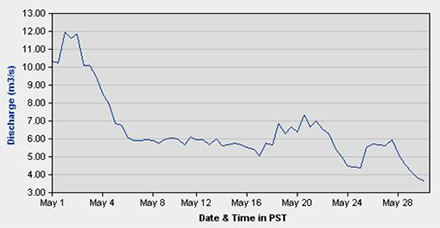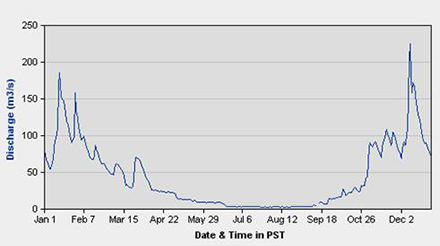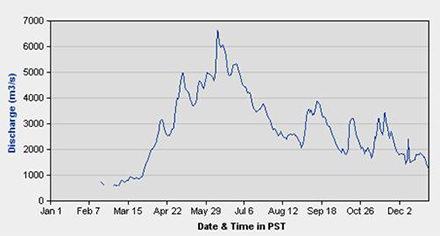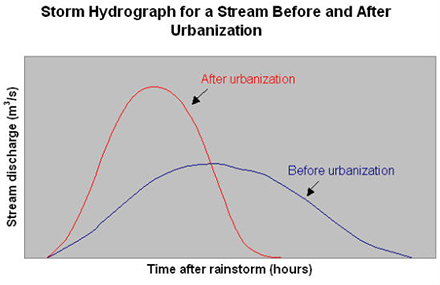Overview
As anyone who has lived near a river or stream knows, the character of the flowing water changes according to time of day, year, season, and during extreme events such as floods and droughts. Watercourses may be a mere trickle at certain times, and a raging torrent at other times. The important point is that no stream or river is completely stable; as in life, the only constant in a river or stream is change. This section concerns the variability of water flows in the watershed and how human developments alter this variability.
Despite the sometimes enormous magnitude of these changes, over the eons river systems achieve a balance with the surrounding landscape. The vegetation and animal life that is part of the system adapts to and thrives in the local conditions. Even apparently catastrophic floods are part of a great cycle of cleansing and renewal. Water flows in rivers and streams are closely connected with the function of other ecosystems such as forests and meadows, lakes, wetlands and marine shorelines.
Stream flows can be significantly altered when rivers are dammed, when streams are channelized for better drainage of the land, when riparian vegetation is removed, and when the land in the watershed is modified, for example by urbanization that causes an increase in impervious surfaces. Although in some cases this alteration is necessary for benefits such as hydropower generation, food production, timber harvesting and economic development, many of the consequences have only recently been recocognized. Some of the impacts on streams and rivers include pollution, excess erosion and/or sedimentation, increased flooding, falling water tables, habitat loss, and the collapse of some fisheries.
In order to preserve the function of streams and rivers, along with their valued products and services, we need to find better ways of working with these dynamic systems, and encouraging development that has a minimal impact on them. Understanding the importance of variability in flows is therefore necessary in order to reduce the degradation of natural water bodies.
How are stream flows studied?
One method of studying stream flows involves calculating the discharge of a particular stream or river. Discharge is the measure of the volume of water that passes a point in a given period of time, usually noted in cubic metres per second, m3/s (there are 1000 litres in a cubic metre). The discharge can be obtained by a couple of different methods.
In the area-velocity method, the cross-sectional area of the stream is determined, and the velocity of the water is measured with a current meter, at regular intervals and depths across the stream. A Gurley meter, for example, uses cups that rotate in the current and measures the revolutions per second. For streams small enough for a person to wade across, the current meter can be hand-held. For larger streams and rivers, it is suspended from a cable or bridge. The velocity of the water (measured in metres/second) is multiplied by the area (measured in square metres), to obtain the discharge (in metres3/second). The discharge can be calculated for different sections of the stream, and averaged. Automated instruments can continuously monitor stream discharge.
Discharge can also be measured with weirs and flumes, structures that are placed across small streams and control the amount of water that flows through some opening; this allows easy measurement. A common type is a V-notch weir, a small dam with a V-shaped opening in the middle.
Once the discharge of a stream is measured, a hydrograph can be drawn. A hydrograph is essentially the “flow signature” of a stream, and measures the discharge or the water level over time. Hydrographs are very useful for characterizing streams and rivers, for example to note how quickly they rise in response to rain storms, or at what time of the year peak flows occur. Below is an example of a hydrograph for Englishman River, near Parksville, for the month of May, 2004 (source: Environment Canada:
Real Time Hydrometric Data).

Hydrograph for Englishman River for May, 2004
What natural factors influence stream flows?
The flows of rivers and streams differ according to a number of factors:
- Climate (i.e. the long-term weather trends of an area) determines: how much rain falls and at what times of the year; how much snow falls and when it melts; when and to what extent drought occurs; and if and when the stream freezes over.
- Topography and relief (i.e. the shape of the land and difference in elevation): streams that flow down steep terrain, with a sudden change in elevation, flow more quickly than those in flat valley bottoms. Streams that are surrounded by steep terrain also usually recharge with rainwater and snowmelt more quickly than streams in more flat country.
- The size of the watershed, as well as the number of tributaries within it, affects the volume of water in a stream or river. A very large watershed, such as that of the Fraser River, can span a number of different types of landforms and ecosystems that affect the flows of the river in different ways.
- Geology (the type and character of rock and soil): this factor determines how much rain water soaks into the ground, compared to the amount that flows across the surface. For example, in areas with a lot of exposed bedrock, much of the rainwater flows across the surface and quickly raises water levels in nearby streams. In areas with highly permeable soils, on the other hand, flows increase and decrease more gradually before and after a rainfall, due to the sponge-like nature of the surrounding soils. Geology also determines where the groundwater flows and how quickly it seeps into rivers as baseflow.
- Vegetation soaks up water from the ground, and contributes to the ability of soils to soak up water, with its contribution of spongy organic material (i.e. accumulations of dead leaves and forest litter). Therefore, areas with lush vegetation normally experience more gradual increases and decreases in water levels and discharge, since infiltration and evapotranspiration are increased (see also The Water Cycle for explanations of these terms).
- Large woody debris, e.g. fallen trees, is very important in many streams for dissipating the energy of water flows, for creating pools and off-channel fish habitat, for capturing sediment and protecting stream banks. Removing this debris can increase flows and cause erosion.
- Storage capacity is provided by riparian zones (water-loving vegetation, saturated soils and their associated ecosystems), wetlands and lakes. Storage allows the system to absorb large volumes of rainfall and snowmelt without flooding.
A hydrograph depicts the “flow signature” of a particular river or stream, and can vary greatly depending on the above factors. For example, the Cowichan River, on Vancouver Island, experiences peak flows over the winter, in response to the winter rains in this part of the province. The Fraser River, on the other hand, experiences peak flows during the spring to early summer, due to snowmelt in the interior mountains. These two hydrographs are shown below.

Hydrograph for Cowichan River, BC, 2003

Hydrograph for Fraser River, near Hope BC, 2003
Why is natural variation in flows important?
Plants and animals have evolved over the millennia to thrive in the natural cycles of high and low flows that are particular to a local area. Until recently, river management has mainly focused on maintaining a minimum low flow, with the goal of maintaining certain fish stocks. Unfortunately, experience is proving that streams and rivers are highly complex and cannot necessarily be managed for one species or human value in isolation of other components of the system.
Naturally low flows are necessary for insect breeding in the floodplain, to provide sheltered pools for juvenile fish and to allow floodplain vegetation to mature. Naturally high flows help to shape the channel, flush wastes and provide spawning cues for fish. Natural floods replenish floodplains with nutrient-laden sediment, allow fish to access shallow areas, and disperse the seeds and fruits of floodplain plants. These functions are summarized in the table below.
High and low flows in themselves are not necessarily sufficient to maintain ecological functions in a stream. The timing, duration, frequency and magnitude of these events are also crucial. Variations in flows still occur in altered streams, for example when water is released or withheld from dams according to hydropower needs, or when runoff from impervious surfaces causes sudden high flows. However, in such cases the flow events occur at unnatural times and frequencies that do not necessarily benefit riparian ecosystems.
Table 1. Functions of different naturally occurring flow levels in unaltered streams and rivers
| Extreme low flows (droughts) | Seasonal low flows | Seasonal high flows | Extreme high flows (floods) |
- Some plants die due to lack of water and forest fires; new areas for growth opened up
- Plants establish in stream channel and on floodplain, provide nutrients when water returns
- Fish and other aquatic prey become isolated in pools; provide food for predators
| - Calm waters allow juvenile fish sheltered areas in which to grow
- Standing pools of water allow aquatic insects to reproduce
- Transportation pathways opened up for larger mammals
- Seed and fruit production triggere
| - Physical character of stream channel shaped (e.g. pools and riffles)
- Fish spawning triggered
- Fish eggs in spawning beds aerated by turbulent flows
- Riparian vegetation prevented from encroaching into channel
- Wastes, excess sediment flushed downstream
| - Large landscape features reshaped (e.g. deltas, new channels)
- Vegetation cleared from channels/banks; new areas opened up for plant growth
- Gravel/cobble deposited in spawning areas
- Nutrients from land flushed into stream
- Nutrient-rich sediments deposited on floodplain
- Seeds/fruits of floodplain plants dispersed
|
How do people alter water flows?
Large Infrastructure & Water Works
Beginning centuries ago, people have sought to control the often destructive and unpredictable flows of large rivers. This endeavour became more successful with more powerful tools and technology. Some examples of deliberate alterations of stream and river flows include: dams used for hydroelectric power, irrigation and drinking water; dykes and levees built to protect human settlements along floodplains; channelization (widening, deepening and straightening) of rivers to facilitate shipping; ditching and drainage of low-lying agricultural land for agriculture. These modifications have had enormous effects on watersheds, water supply and water flows (see More Information).
Water Extraction
Other, more subtle modifications also affect water flows. When a lot of water is extracted from rivers or groundwater sources for irrigation and drinking, stream flows can be diminished. This is a big problem in dry areas such as the Okanagan, and in rivers that have a high demand placed on them such as the Columbia River. Even some streams in the Victoria area, such as Millstream Creek, have recently ceased to reach the ocean at times during the summers. The effects of urbanization.
Impervious Surfaces
One of the most pressing issues in watersheds of the Victoria area is the effects of urbanization. When large natural storage areas such as wetlands and riparian zones are lost to development, rivers often become more “flashy.” In other words, they respond more quickly to increases and decreases in precipitation. This can lead to more floods and cause damage to stream channels. Increases in impervious surfaces (i.e. paved roads, parking lots, building roofs) in urban areas in general are also responsible for this effect (see also
Natural vs. urban watersheds). The hydrograph of a stream before and after urbanization reveals how impervious surfaces affect streams, as shown in the diagram below.
Water flows quickly off impervious surfaces, rather than percolating slowly into the ground as it would do in a natural watershed. Therefore, the discharge and water level in a stream increases suddenly. Since impervious surfaces do not allow water storage, the levels also drop quickly. These sudden changes in discharge also indicate changes in the energy of a stream. The effect on the stream channel is similar to that of turning a firehose loose on your garden for short periods of time. Sudden torrents of water scour stream banks, causing erosion. The soils and sediment that are washed into the water can smother fish spawning beds and other aquatic habitat, and degrade water quality so that less vegetation and fewer aquatic animals can survive.

Groundwater
Another common consequence of urbanization is depleted groundwater. In natural watersheds, forest cover, riparian vegetation and permeable soils encourage much of the rain water to soak into the ground, where it contributes to groundwater reserves. Unlike surface water, groundwater is often very slow-moving and requires years to centuries to replenish once it is depleted. These reserves are important drinking water sources in many areas. Groundwater also maintains stream baseflow in the dry summer months, which is necessary to prevent streams from drying up, and nourishes riparian vegetation. Both sufficient stream flow and riparian vegetation are necessary to maintain freshwater ecosystems, which are composed of the interactions among plants, invertebrates, fish, birds and mammals (see
Riparian Zones).
Large Woody Debris Removal
Removal of naturally occurring large woody debris (LWD), such as fallen trees, is a common consequence of urbanization. It is often removed in order to “clean up” streams and in order to remove a perceived risk to property. LWD is now recognized as an important component of many streams, as it helps to dissipate flows and provides fish habitat.
Flood Protection Walls
When watercourses are confined with dykes, levees and retaining walls, they are separated from their floodplains. Normally, the floodplain helps to dissipate the energy of high flows by allowing the water to spread out over a shallow area, and helps to absorb and store excess water. When buildings, roads and other structures are built in the floodplain, protective walls become necessary to prevent property damage due to floods. However, the increased stream energy is merely transferred farther downstream, where it can cause serious damage to stream channels and adjacent property and habitat. Large floods sometimes even overtop these walls. A better option for protecting the function of the stream can sometimes involve moving the dykes back and restoring at least some of the floodplain, while still retaining flood protection.
People who live along streams and lakes sometimes build retaining walls along their property to protect the banks and shorelines from erosion. Paradoxically, these structures can actually increase erosion by redirecting water energy to the sides and base of the wall. Retaining walls also do not have any water storage capacity, compared to natural riparian vegetation; therefore, they contribute to the “flashy” flows described above in urbanization and impervious surfaces. In order to avoid the issue of erosion in the first place, it is generally more advisable to place structures, roads and trails some distance back from the water’s edge, and to preserve or plant natural vegetation along stream banks (see
shoreline and streamside development).
Consequences of Flow Alterations – a Change in Thinking
Many of the problems relating to alterations of stream flows stem from a general objective that until recently has guided water management: that is, to get the water off of the land as quickly as possible. This thinking is understandable, in terms of a short-term strategy to avoid flood damage, but in the long term it may do more harm than good. Shipping the water off the land, with vast networks of gutters, storm drains, culverts and drainage ditches, deprives both people and ecosystems of a most precious resource and has lead to a number of problems, such as:
- increased erosion and damage to stream channels, from high volumes of water flowing into natural water bodies
- property damage and habitat loss, caused by excessive erosion and sediment deposition
- greater amounts of chemicals, nutrients and bacteria flushed off agricultural and urban surfaces, into natural water bodies
- depleted groundwater, which is necessary for drinking, irrigation and to maintain stream flows during the summer
- increased financial costs related to maintaining and installing drainage systems and repairing flood damage
A shift in thinking is currently underway, whereby local governments and planners are treating stormwater as a resource rather than a liability. This approach is sometimes called “integrated stormwater management,” since it combines the objectives of maintaining riparian ecosystems, protecting human property, improving water quality and saving money. A variety of techniques can be used to reduce human impacts on stream flows, while allowing for appropriate development and flood protection.
How can human influences on water flows be reduced?
Generally, actions that restore the natural flow patterns in the watershed help to prevent the problems outlined in the previous sections, and achieve the greatest success in stream and river restoration. Of course, completely restoring such patterns may not be feasible in some highly altered rivers, for example those that are relied upon for major power generation or that are located within a large urbanized area. Nevertheless, mimicking natural flows, even on a reduced scale, has many potential benefits for the function of riparian ecosystems. Here are some examples of possible methods to accomplish this:
- Activities in the watershed that may affect stream flows must be carefully planned, assessed and monitored, for example logging, new construction and agriculture. Appropriate set-backs from riparian zones and floodplains, and “best management practices” (BMPs), are two tools that can be used to moderate human impacts on stream flows.
- Storage capacity and infiltration of rainwater in the watershed can be increased by protecting natural forests, wetlands and riparian zones. This can even be successful in urban or suburban areas; for example, these areas can be combined with public green space and linear parks. Greater infiltration of rainwater in naturally vegetated areas reduces the volume that flows across impervious surfaces and subsequently disrupts stream flows.
- Where natural reservoirs and wetlands do not exist, constructed wetlands and stormwater detention ponds are sometimes effective, both for water storage and to help treat polluted runoff from urban and industrial areas. Impervious surfaces in general can be limited and reduced with a wide range of alternative materials and practices (see How can I help reduce impervious surfaces?).
- Large woody debris can be left in streams, where possible, to help protect stream banks, dissipate the energy of high flows and provide habitat.
- Where appropriate, streams can be reconnected with their floodplains, by removing and setting back dykes and water retaining walls.
- Native riparian vegetation can be left in place or replanted, in order to help stabilize shorelines and streamsides, protect against erosion, help restore natural flows and increase water storage in these areas. This can even be done by individual owners of waterfront property (see shoreline/streamside development for more tips).
- In rivers that are dammed, water releases and retentions can sometimes be timed to mimic natural flows, while still serving human needs. Increasingly, dams are being decommissioned, where they have outlived their usefulness, or where their negative consequences outweigh their benefits. This is a complex endeavour that requires interdisciplinary planning and cooperation (see “River Recovery: Restoring Rivers Through Dam Decommissioning” under Additional Information & Links > Websites).
Additional Information & Links
Websites
Articles